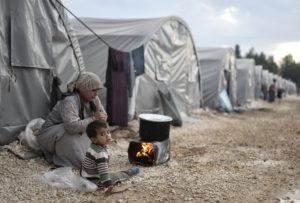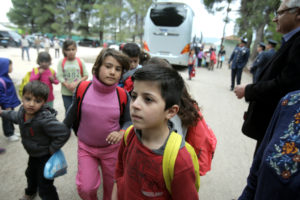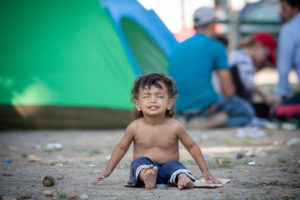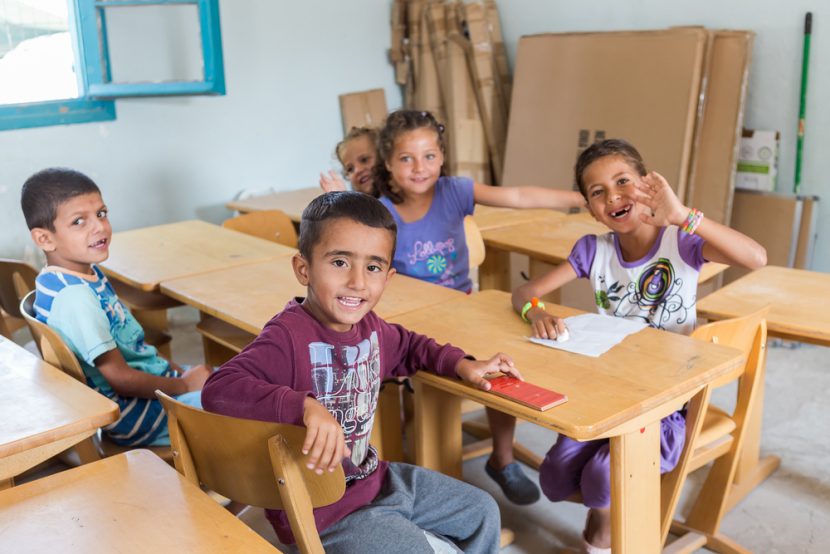In 2015, the EU received 1,321,600 asylum applicants and almost 30% of these applicants were children (European Union Committee, 2016). These refugees have to face many problems; not only do they have to abandon their homes and their families, but they also have to assimilate into a completely new country where the youngest of them are faced with numerous challenges.
A new future for the young refugees
The situation is real. “More than one million new arrivals have come to Germany, the preferred destination, in 2015 alone” (Harris, n.d). Many of them are parents, seeking only one thing – a better future for their children. Now, they and their children have to learn how to integrate into completely new surroundings. This is sometimes a difficult task for children.

Education is the key but also a challenge
The global community has a responsibility to help with providing housing, clothing and food for refugee children, but there is also a moral responsibility to use education to help them build a better future. Many see education as the only effective way for integration, and they are right because integration works best in educating young refugee populations. However, although in some countries refugee children can attend school as any other non-refugee child, in other European countries they are not completely included in the national education system. The sad fact is that their education occurs in exile and they only get one shot. “They need access to a complete education, preferably to be fully included in the national education system of the country of refuge” (Dryden-Peterson, n.d.).
The process of integrating refugees into national education systems is a political, economic, and social challenge which is why the global community should support the teachers and Ministries of Education who will eventually be responsible for executing this integration.
Integrating immigrants into national education systems means stability for the children. If they want to have a stable future, they, as any other child in that system, need to have trained teachers, a well-developed curriculum that will build their skills and knowledge, and the possibility of certifying their learning. They cannot achieve that outside of the system (Dryden-Peterson, n.d.).
Director of the German Philologist Association Heinz-Peter Meidinger, whose members are teachers at the country’s high schools, emphasizes, “If we want integration to succeed, then we mustn’t have classrooms that are 100 percent refugee children” (Bleiker, 2015).
Social inclusion of refugee children
Being included physically in national schools is very important, but it is merely an initial step. The following step and yet another challenge is that refugee children also be socially included. For refugee children, schools are “the most important place of contact with members of local host communities, playing an important role in establishing relationships supportive of integration” (Ager & Strang, 2008).
Still, there are a number of barriers hindering their successful integration into the education system. Many refugee children suffer both physical and emotional bullying in schools, racism, difficulties in making friends etc., when in fact they should be experiencing belonging and connection in order to learn. 
The German Philologist Association points out that if more than 30 percent of children in a classroom don’t speak good German, the quality of education will suffer (Bleiker, 2015). This has a negative impact on non-refugee children in the same class who might achieve more because their tempo of learning, unlike refugee children, is quicker, but it also has a negative impact on refugee children because they will struggle very much to integrate.
This is where teachers play an important part. Any teacher of refugee students has a clear priority to perform training “to meet refugee students’ social, emotional, and learning needs and to help refugee and national students understand each other and get along” (Dryden-Peterson, n.d.).
Lack of political support
Integrating refugee children into national education systems is a good thing, but it becomes a political challenge once faced with the limitation of resources in reality. Countries that have a large number of refugees also have education systems that lack resources. Once we realize that education in general receives less than two percent of humanitarian aid, an explanation for such reality become much clearer. This is why the integration of refugees into education systems and the training of teachers must receive both political and financial support. 
For now, the situation is not ideal. There are many political and social factors making the integration more difficult but the struggle to integrate is real. The situation in both refugee countries and classes clearly needs improvement. The classes are full, sometimes there are more than 30 students in one class, but the only alternative would be that the children from refugee families don’t go to school. This should not be accepted as an alternative at all.
Written by: Ivana Kaćunko Internally proofread by: Lucy Autin Externally proofread by: Thelma Obiakor |
Ager, A., & Strang, A. (2008, April). Understanding Integration: A Conceptual Framework. Journal of Refugee Studies, 21(2). Retrieved March 18, 2017, from: http://www.cpcnetwork.org/wp-content/uploads/2014/04/19.-Ager-Strang-Understanding-Integration-2008.pdf
Bleiker, C. (2015, 10 15). How to integrate refugee kids in German schools. Retrieved March 18, 2017, from Deutsche Welle: http://www.dw.com/en/how-to-integrate-refugee-kids-in-german-schools/a-18785567
Dryden-Peterson, S. (n.d.). A Future for Syrian Children: Integration in National Education Systems. Retrieved March 18, 2017, from The Huffington Post: http://www.huffingtonpost.com/sarah-drydenpeterson/a-future-for-syrian-child_b_8631316.html
European Union Committee. (2016, July 26). Children in crisis: unaccompanied migrant children in the EU. Retrieved March 18, 2017, from: http://www.scepnetwork.org/images/21/295.pdf
Harris, D. (n.d). Europe and Migration: Five Challenges. Retrieved March 18, 2017 from Huffington Post: http://www.huffingtonpost.com/david-harris/europe-and-migration-five_b_8798548.html


